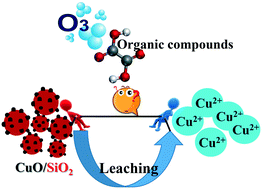当前位置:
X-MOL 学术
›
Environ. Sci.: Water Res. Technol.
›
论文详情
Our official English website, www.x-mol.net, welcomes your
feedback! (Note: you will need to create a separate account there.)
Metallic ion leaching from heterogeneous catalysts: an overlooked effect in the study of catalytic ozonation processes
Environmental Science: Water Research & Technology ( IF 3.5 ) Pub Date : 2017-10-02 00:00:00 , DOI: 10.1039/c7ew00273d Wenwen Yang 1, 2, 3 , Bernhard Vogler 2, 3, 4 , Yu Lei 2, 3, 5 , Tingting Wu 1, 2, 3
Environmental Science: Water Research & Technology ( IF 3.5 ) Pub Date : 2017-10-02 00:00:00 , DOI: 10.1039/c7ew00273d Wenwen Yang 1, 2, 3 , Bernhard Vogler 2, 3, 4 , Yu Lei 2, 3, 5 , Tingting Wu 1, 2, 3
Affiliation

|
Heterogeneous catalytic ozonation has been increasingly studied for the degradation and mineralization of refractory organic water pollutants in recent years. Compared with homogeneous catalysts, an important advantage of heterogeneous catalysts is that they can be easily separated from the treated water, making the process economically viable. While many studies have focused on the development and evaluation of metal oxide-based catalytic ozonation, possible leaching of metal ions and the subsequent effect on the contaminants' degradation are sometimes overlooked. Here, we examined metal leaching from several solid catalysts and further investigated the influence of the leached metal ions on the mineralization of two model compounds (oxalate and nitrobenzene) during continuous ozonation. Metallic ion leaching was observed from both commercially-available catalysts and catalysts prepared via wet-chemistry methods in the lab. The water matrix has been demonstrated to play an important role in metal leaching. The homogeneous catalytic effect resulting from the leached metal ions was found to be significant. A mechanism involving the formation of an unstable Cu(III)/oxalate complex through the reaction between ˙OH and Cu(II)/oxalate was proposed to explain the experimental observations. Our results indicate that the stability of the solid catalysts and the effects of the leached ions must be carefully examined during the catalytic ozonation of organic contaminants. Through this study we highlight the importance of rigorous, accepted protocols for evaluating and reporting heterogeneous catalyst performance in water/wastewater treatment within the research community.
中文翻译:

非均相催化剂中的金属离子浸出:催化臭氧化过程研究中被忽视的效应
近年来,越来越多地研究非均相催化臭氧化技术对难降解有机水污染物的降解和矿化作用。与均相催化剂相比,非均相催化剂的一个重要优点是它们可以轻松地从处理后的水中分离出来,从而使该方法在经济上可行。尽管许多研究都集中在基于金属氧化物的催化臭氧化的开发和评估上,但有时会忽略金属离子的可能浸出及其对污染物降解的后续影响。在这里,我们研究了从几种固体催化剂中浸出的金属,并进一步研究了浸出的金属离子对连续臭氧化过程中两种模型化合物(草酸盐和硝基苯)矿化的影响。通过实验室中的湿化学方法。已证明水基质在金属浸出中起重要作用。发现由浸出的金属离子产生的均相催化作用是显着的。一种机制,涉及通过andOH和Cu(II)之间的反应形成不稳定的Cu(III)/草酸酯配合物)/草酸盐被提出来解释实验观察。我们的结果表明,在有机污染物的催化臭氧化过程中,必须仔细检查固体催化剂的稳定性和浸出离子的影响。通过这项研究,我们强调了严格的,公认的协议对于评估和报告研究社区内水/废水处理中非均相催化剂性能的重要性。
更新日期:2017-10-27
中文翻译:

非均相催化剂中的金属离子浸出:催化臭氧化过程研究中被忽视的效应
近年来,越来越多地研究非均相催化臭氧化技术对难降解有机水污染物的降解和矿化作用。与均相催化剂相比,非均相催化剂的一个重要优点是它们可以轻松地从处理后的水中分离出来,从而使该方法在经济上可行。尽管许多研究都集中在基于金属氧化物的催化臭氧化的开发和评估上,但有时会忽略金属离子的可能浸出及其对污染物降解的后续影响。在这里,我们研究了从几种固体催化剂中浸出的金属,并进一步研究了浸出的金属离子对连续臭氧化过程中两种模型化合物(草酸盐和硝基苯)矿化的影响。通过实验室中的湿化学方法。已证明水基质在金属浸出中起重要作用。发现由浸出的金属离子产生的均相催化作用是显着的。一种机制,涉及通过andOH和Cu(II)之间的反应形成不稳定的Cu(III)/草酸酯配合物)/草酸盐被提出来解释实验观察。我们的结果表明,在有机污染物的催化臭氧化过程中,必须仔细检查固体催化剂的稳定性和浸出离子的影响。通过这项研究,我们强调了严格的,公认的协议对于评估和报告研究社区内水/废水处理中非均相催化剂性能的重要性。











































 京公网安备 11010802027423号
京公网安备 11010802027423号